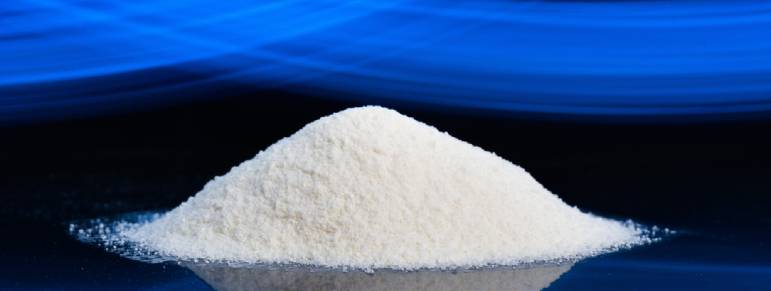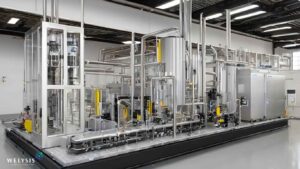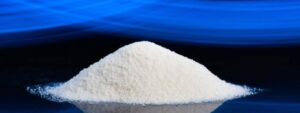Chlor-alkali electrolysis is a fundamental process for the manufacture of essential chemicals such as sodium hypochlorite, sodium hydroxide or hydrochloric acid. These products have a considerable impact on various industries, including the manufacture of plastics, pharmaceuticals, textiles and water purification.
The technology used in this process has, over recent years, evolved to become more efficient and environmentally friendly, minimizing energy use and reducing emissions. This progress has been achieved through innovations in membrane cells, a key technology in modern electrolysis.
What is chlor-alkali electrolysis?
The chlor-alkali electrolysis process involves the use of electric current in electrolytic cells to cause the separation of the main components of the salt (sodium chloride) and the simultaneous generation of its gas molecules chlorine and hydrogen in addition to the production of sodium hydroxide thanks to the electrolysis of water
The most advanced technologies in this field use membrane cells, which allow for cleaner and more efficient production, without the need for mercury or diaphragms that were common in earlier techniques.
Chlor-alkali electrolysis and by-products: key applications
Chlor-alkali electrolysis allows the manufacturing of several essential products for industry, including sodium hypochlorite, sodium hydroxide and hydrochloric acid, each with multiple applications that are essential for different industrial and commercial sectors, for example:
Sodium hypochlorite
Sodium hypochlorite, commonly known as bleach or chlorine, is a powerful disinfectant and bleaching agent that is widely used in a variety of industries and domestic environments. Its most prominent applications include:
- Water treatment: It is extensively used in the treatment and disinfection of drinking water and wastewater. Thanks to its ability to kill bacteria, viruses and other microorganisms, sodium hypochlorite ensures the safety of the water supply.
- Disinfection: In hospitals, health care facilities and other public places, sodium hypochlorite is vital for the disinfection of surfaces, equipment and spaces. Its ability to combat a wide range of pathogens makes it a crucial ally in infection prevention.
- Bleaching: It is a key ingredient in the textile industry, where it is used to bleach fabrics, as well as in the manufacture of household cleaning products such as bleaches and detergents.
- Food processing: In the food industry, it is mainly used for the disinfection of fruits, vegetables and processing equipment, ensuring food safety and preventing food contamination.
More information on sodium hypochlorite production plants.
Sodium hydroxide
Sodium hydroxide, also known as caustic soda, is another crucial by-product of chlor-alkali electrolysis. This alkaline compound has multiple uses in various industries due to its high reactivity and versatility.
- Chemical industry: Sodium hydroxide is an essential reagent in the manufacture of a variety of chemical products, including soaps, detergents and cleaning products. It is essential in the production of biodiesel, where it is used in the transesterification of fats and oils.
- Paper and pulp: In the paper industry, it is used in the manufacture of wood pulp, helping to break down lignin and other impurities present in plant fibres. This process is essential to produce high-quality white paper.
- Water treatment: Sodium hydroxide is used to adjust the pH of water in water treatment plants, helping to neutralize acids and precipitate heavy metals. This makes it a key component in water purification.
- Food industry: In food processing, it is used in the manufacture of products such as pretzels, where it gives them their distinctive golden crust. It is also used to peel fruits and vegetables, improving processing efficiency.
Read more about sodium hydroxide production plants.
Hydrochloric acid
Hydrochloric acid, another product obtained from electrolytic chlorine, is a highly concentrated aqueous solution of hydrogen chloride, used in a variety of industrial applications. Some of its main applications include:
- Metallurgical industry: hydrochloric acid is used in metal pickling, where it helps to remove oxides and contaminants from metal surfaces before they are treated or coated. It is essential in the production of steel and other metals, ensuring clean surfaces ready for processing.
- Water treatment: In water treatment plants, it is used to adjust pH and neutralize alkaline solutions. It is particularly useful in the regeneration of ion exchange resins, used in water demineralization.
- Chemical industry: It is an essential component in the synthesis of various chemical compounds, including plastics and pharmaceuticals. It is also used in the production of calcium chloride, a compound used for de-icing and in the food industry.
- Industrial processes: In oil production, hydrochloric acid is used in oil well stimulation, where it is injected into rock formations to increase permeability, and improve oil and gas extraction.
Read more about hydrochloric acid production plants. hydrochloric acid production plants.
Innovations in sustainability
One of the main challenges of chlor-alkali electrolysis is its high energy consumption. However, technological advances have made the process more sustainable. Membrane cells are an example of this innovation, as they reduce energy consumption and minimize environmental impact.
In addition, the integration of renewable energy sources into this process is opening new opportunities to further reduce CO2 emissions.
Read more about the potential for electricity cost savings in electrolysis plants.
Contribution to the circular economy
The chlor-alkali industry is also aligned with the principles of the circular economy. By-products of this process, such as hydrogen, are increasingly being deployed in clean energy applications, such as fuel cells and the production of green ammonia.
This not only optimizes resource use but also contributes to the decarbonization of key industrial sectors.
Challenges and opportunities
Although the chlor-alkali electrolysis process has come a long way, it still faces challenges related to energy efficiency and waste reduction. The industry is working on technological solutions and cross-sector collaborations to overcome these challenges. The adoption of new technologies, such as digitization and real-time monitoring, also promises to improve operational efficiency and reduce waste.
In summary, chlor-alkali electrolysis remains an essential component for many industries, and its advances in sustainability and energy efficiency position it as a key technology for the future of industrial production.





